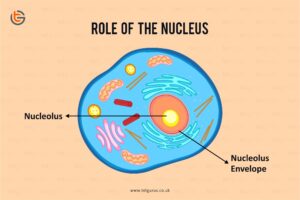Cell nucleus: its purpose and functions
 The cell nucleus is a membrane-bound organelle that plays a crucial role in the control and regulation of cellular activities. It is often referred to as the “brain” or “control center” of the cell due to its central role in genetic information storage and management. Here are extensive notes describing the functions of the cell nucleus:
The cell nucleus is a membrane-bound organelle that plays a crucial role in the control and regulation of cellular activities. It is often referred to as the “brain” or “control center” of the cell due to its central role in genetic information storage and management. Here are extensive notes describing the functions of the cell nucleus:
- Genetic Information Storage:
- The primary function of the cell nucleus is to store the genetic information in the form of DNA (deoxyribonucleic acid). DNA contains the instructions for the synthesis of proteins and the regulation of various cellular activities.
- DNA Replication:
- Before cell division, the nucleus is responsible for overseeing the replication of DNA. This ensures that each daughter cell receives an identical copy of the genetic material.
- Transcription:
- Transcription is the process by which the genetic information in DNA is used to synthesize messenger RNA (mRNA). This process occurs in the nucleus, where the DNA serves as a template for the synthesis of complementary mRNA molecules.
- mRNA Processing:
- While mRNA is transcribed in the nucleus, it undergoes various processing steps, including capping, splicing, and polyadenylation. These modifications are essential for the stability, transport, and translation of mRNA in the cytoplasm.
- Ribosomal RNA Synthesis:
- The nucleus is responsible for the synthesis of ribosomal RNA (rRNA), which is a crucial component of ribosomes. Ribosomes are cellular structures where protein synthesis occurs, and they consist of both rRNA and proteins.
- Nuclear Pore Complexes:
- The nuclear envelope, which surrounds the nucleus, contains nuclear pore complexes. These structures regulate the movement of molecules, including mRNA and proteins, between the nucleus and the cytoplasm. This control is essential for maintaining the integrity of genetic information.
- Cellular Organization and Structure:
- The nucleus helps maintain the structural integrity and organization of the cell. It is typically located near the center of the cell, and its presence contributes to the overall shape and organization of the cell.
- Cell Cycle Regulation:
- The nucleus plays a central role in the regulation of the cell cycle. It coordinates processes such as DNA replication and cell division, ensuring that these events occur in a controlled and orderly manner.
- Storage of Genetic Instructions:
- In addition to DNA, the nucleus stores other genetic instructions in the form of non-coding RNAs, such as microRNAs and long non-coding RNAs. These molecules play roles in the regulation of gene expression and other cellular processes.
- Response to Environmental Stimuli:
- The nucleus is involved in sensing and responding to various environmental stimuli. It can activate or repress specific genes in response to signals, allowing the cell to adapt to changing conditions.
In summary, the cell nucleus is a multifunctional organelle that governs the storage, processing, and regulation of genetic information. Its activities are essential for the proper functioning, growth, and reproduction of eukaryotic cells.



